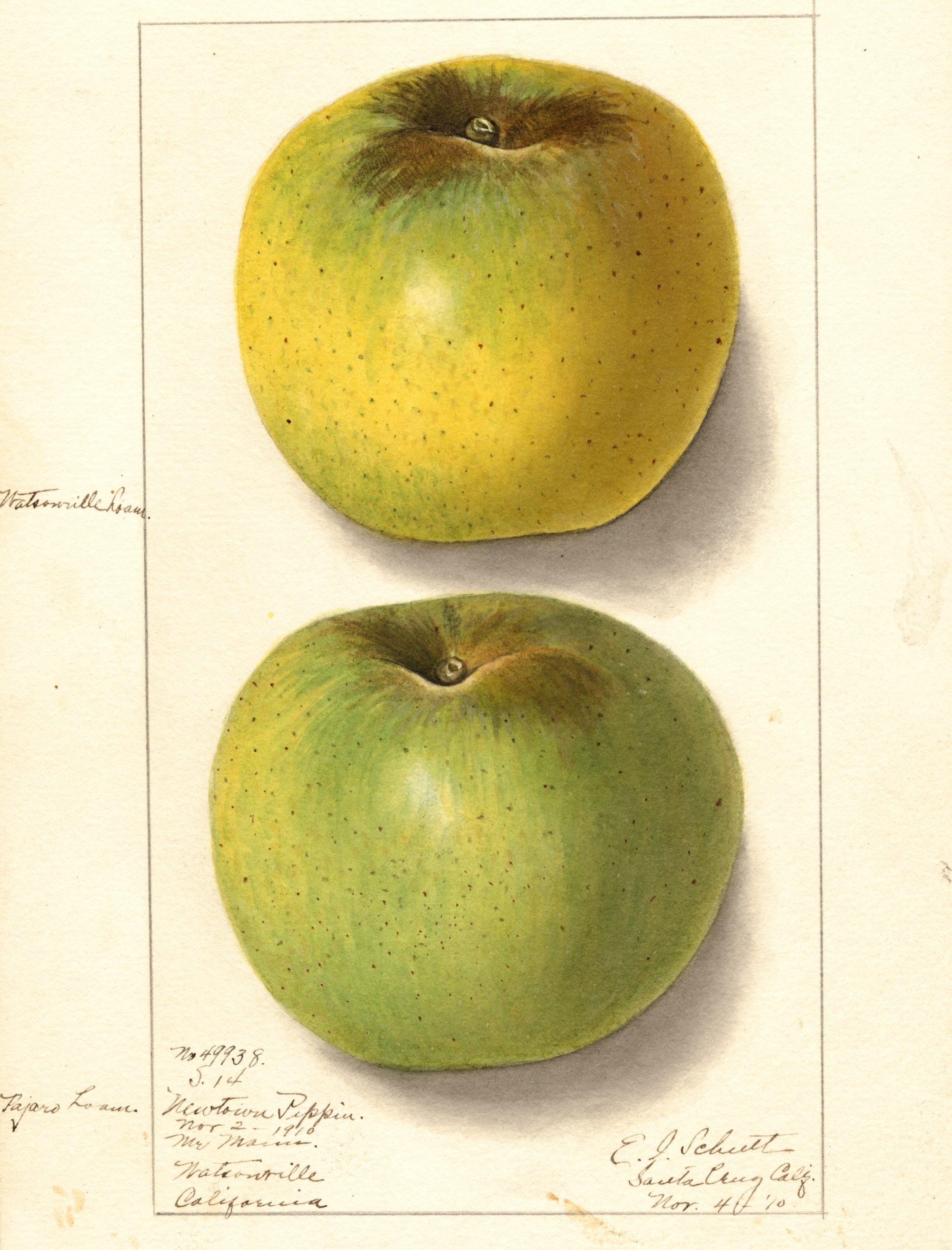Apples do not grow true. If you plant a Gravenstein apple seed (called a pip) the tree that results will not produce Gravenstein apples. It may share some similar traits with the parent apples but it will be its own unique type of apple. Most of the time this seedling apple will not be good to eat and is only suitable for blending into cider. Every once in a while a seedling apple will be discovered in the orchard with special character and these winners of the genetic lottery can be propagated widely by grafting cuttings of the tree’s branches onto rootstock to create a clone of the original tree. Every well-known type of apple is a grafted clone of a tree that was discovered by a farmer and deemed to be special.
The name of the Newtown Pippin tells you the origin of the apple. Since a pip is the seed of an apple, a pippin is the term for an apple tree that was grown from a seed. The Newtown Pippin is thus a seedling found in the village of Newtown on Long Island (now the Elmhurst neighborhood in Queens) in the 17th century.

The History of the Newtown Pippin Apple
The traits of the Newtown Pippin made it the perfect apple for colonial America. Not only was it an excellent eating, cooking, and cidermaking apple, but it also stored exceptionally well. The Newtown Pippin will keep for months at room temperature and many of its best flavors emerge over time.
By the mid 18th century, widespread advertising of Newtown Pippin nursery trees can be found in newspapers throughout the colonies. Popularity grew further when Benjamin Franklin wrote his wife from an assignment in London in 1759 asking her to send him some Newtown Pippin apples. As Franklin shared the apples in London society, their fame grew and soon after scion wood was being sent to England for propagation. The Newtown Pippin was not well-suited for growing in England, but its popularity remained and Newtown Pippins apples soon start being exported to England and the rest of Europe.
Newtown Pippin was widely planted and spread to many regions of the United States. In 1777, Thomas Walker returned home to Virginia from war bringing with him scions of the Newtown Pippin. He renamed his Newtown Pippin propagations to have a Virginia name of Albemarle Pippin. Identical to the original Newtown Pippin apple other than terroir, Albemarle Pippin developed its own fame. In 1834, a gift of Virginia Albemarle Pippins were presented to Queen Victoria, who was so impressed by it, she made a singular exemption to remove the import duty for Albemarle (Newtown) Pippin apples, which remained in place for nearly 100 years and further drove the plantings of the apple in Britain.
The Newtown Pippin headed west in the mid-19th century. Notable growing regions for the apple were in Hood River Oregon, as well as Pajaro valley near Watsonville, which is where our apples come from. In the Pajaro valley the Newtown Pippins and the Yellow Bellflower apples grew exceptionally well and quickly became over 80% of the local plantings. When the S. Martinelli & Company was formed in 1868 by a Swiss immigrant to made cider, the Newtown Pippin was the backbone of the award winning cider. The floral notes of the Newtown Pippin continued to shine when prohibition forced Martenelli’s to transition to the sweet sparking cider that they are known for today.

Our Apples come from Jake Mann at the Five Mile Orchard which is named for its location, five miles north of Watsonville. Jake’s great-great-grandfather, Samuel Mann started the orchard in the 1870’s and some of the trees in Jake’s orchard date back to Samuel’s son, Franklin. Jake has been an amazing supporter of the cider industry and you will find his apples in many incredible local ciders and we are proud to extend this heritage to apple brandy.
References
Turn them All into Cider (Darlene Hayes)
NY Times Article on the Newtown Pippin
History of the Five Mile House/Orchard
Watsonville Remembered – Agriculture
CiderChat 113 – Jake Mann Interview


